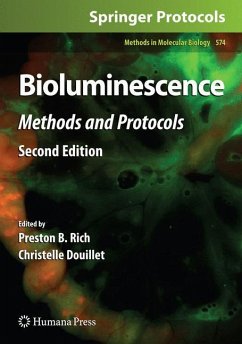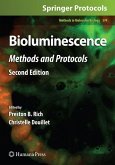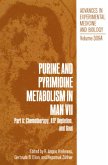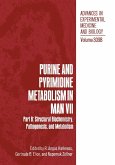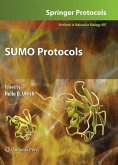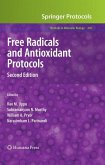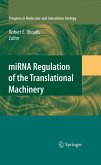Through the study and application of bioluminescence, scientists have painstakingly harnessed a powerful tool that enables us to seek a deeper understanding of the complex mechanisms underpinning so many vital biologic systems. In this fully revised and updated second edition of Bioluminescence: Methods and Protocols, expert researchers contribute a readable and utilitarian compilation of the newest and most innovative techniques that have emerged in this rapidly expanding and progressively diverse field including methods to assess cell trafficking, protein-protein interactions, intracellular signaling, and apoptosis. Also opening up the possibility to visualize and quantify biological mechanisms in real-time and in in vivo settings, the volume also describes the in vivo study of bacterial or viral infections, transplanted cells, stem cells proliferation, vascular flow, and tumors. Written in the highly successful Methods in Molecular Biology(TM) series format, chapters include brief introductions to their respective topics, lists of the necessary materials, equipment, and reagents, step-by-step, readily reproducible laboratory protocols, and notes on troubleshooting and avoiding known pitfalls.
Authoritative and cutting-edge, Bioluminescence: Methods and Protocols, Second Edition provides protocols that are detailed enough to be followed and adapted by scientific teams who have no previous expertise in bioluminescence in order to foster the potentially numerous breakthroughs and new applications from basic to applied science and medicine that must continue to be developed.
Part I I wasraised in a redbrick Baltimore row housewhere summer was marked by the ti- honored ritual of firefly-chasing - a backyard tradition that has endured the gene- tions.Amidtheexcitement,myfatheroftentoldthestoryofhow,whenhewasachild, researchers at the Johns Hopkins University had appealed for the systematic capture of live fireflies en masse. Science had engaged the Baltimore youth in an entrepreneurial quest to jar as many lightning bugs as the dwindling light of dusk would permit. The very next morning, each 100-count glass jar of glowing crawling insects could be exchanged at the University for exactly one crisp dollar bill. Unrecognized at the time by my father, his joyous endeavors had contributed in a profoundwaytotheadvancedmolecularbiologicaltechniquesthatserveasthebasisfor thistextbook.In1947,WilliamMcElroyusedextractsfromthoseveryfirefliestodefine the fundamental reaction underlying the mystical phenomenon of luminescence, and published ''The energy source forbioluminescence in an isolated system'' in the Proceedings of the National Academy of Sciences. Inthedecadessincethatsummer,thestudyandapplicationofbioluminescencehave allowed us to leverage the enduring power of nature's elegance. We have painstakingly harnessedapowerfultoolthatenablesustoseekadeeperunderstandingofthecomplex mechanisms underpinning so many vital biologic systems. This second edition of Methods in Molecular Biology's Bioluminescence: Methods and Protocols serves as a re- ableandutilitariancompilationofthenewestandmostinnovativetechniquesthathave emerged in this rapidly expanding and progressively diverse field. We are indebted to the authors for their thoughtful contributions, inspired by their rigorous dedication to the science of bioluminescence, humbled by theunyielding supportofourcolleagues,andgratefulfortheopportunityprovidedusbyJohnandJan Walker.
Hinweis: Dieser Artikel kann nur an eine deutsche Lieferadresse ausgeliefert werden.
Authoritative and cutting-edge, Bioluminescence: Methods and Protocols, Second Edition provides protocols that are detailed enough to be followed and adapted by scientific teams who have no previous expertise in bioluminescence in order to foster the potentially numerous breakthroughs and new applications from basic to applied science and medicine that must continue to be developed.
Part I I wasraised in a redbrick Baltimore row housewhere summer was marked by the ti- honored ritual of firefly-chasing - a backyard tradition that has endured the gene- tions.Amidtheexcitement,myfatheroftentoldthestoryofhow,whenhewasachild, researchers at the Johns Hopkins University had appealed for the systematic capture of live fireflies en masse. Science had engaged the Baltimore youth in an entrepreneurial quest to jar as many lightning bugs as the dwindling light of dusk would permit. The very next morning, each 100-count glass jar of glowing crawling insects could be exchanged at the University for exactly one crisp dollar bill. Unrecognized at the time by my father, his joyous endeavors had contributed in a profoundwaytotheadvancedmolecularbiologicaltechniquesthatserveasthebasisfor thistextbook.In1947,WilliamMcElroyusedextractsfromthoseveryfirefliestodefine the fundamental reaction underlying the mystical phenomenon of luminescence, and published ''The energy source forbioluminescence in an isolated system'' in the Proceedings of the National Academy of Sciences. Inthedecadessincethatsummer,thestudyandapplicationofbioluminescencehave allowed us to leverage the enduring power of nature's elegance. We have painstakingly harnessedapowerfultoolthatenablesustoseekadeeperunderstandingofthecomplex mechanisms underpinning so many vital biologic systems. This second edition of Methods in Molecular Biology's Bioluminescence: Methods and Protocols serves as a re- ableandutilitariancompilationofthenewestandmostinnovativetechniquesthathave emerged in this rapidly expanding and progressively diverse field. We are indebted to the authors for their thoughtful contributions, inspired by their rigorous dedication to the science of bioluminescence, humbled by theunyielding supportofourcolleagues,andgratefulfortheopportunityprovidedusbyJohnandJan Walker.
Hinweis: Dieser Artikel kann nur an eine deutsche Lieferadresse ausgeliefert werden.
From the reviews of the second edition: "This is a compilation of laboratory protocols dealing with diverse applications of bioluminescence in the biological sciences. ... The book is written primarily for scientists working in the field of biomedical sciences. ... It also provides a number of updated protocols and examples for practicing investigators interested in using bioluminescence in their research. ... This second edition should prove to be a valuable companion to all researchers interested in bioluminescence." (Ruben Mestril, Doody's Review Service, December, 2009)

